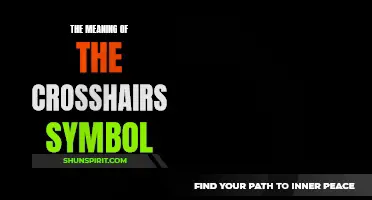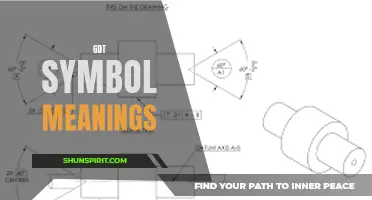
Sicily, the stunning island located in the heart of the Mediterranean, is a treasure trove of ancient symbolism and meaningful traditions. From the iconic Trinacria symbol to the mystical Siren, the island's symbols hold deep cultural, historical, and spiritual significance. They represent the unique blend of influences that have shaped Sicilian identity throughout the ages, creating a rich tapestry of symbolism that continues to captivate and inspire all who encounter it. Join me on a journey through the enigmatic world of Sicilian symbols, as we unravel their meanings and uncover the stories behind these captivating emblems.
What You'll Learn
- What are some common symbols in Sicilian culture and what do they represent?
- Are there any specific symbols or motifs that are unique to Sicily?
- How do Sicilian symbols and meanings differ from other Italian regions?
- What is the significance of religious symbols in Sicilian culture?
- How have Sicilian symbols and meanings evolved over time, and are they still relevant in modern society?

What are some common symbols in Sicilian culture and what do they represent?
Sicilian culture is rich with intricate symbols that reflect the history, traditions, and beliefs of the people. These symbols have been passed down through generations and hold deep meaning for Sicilians. Here are some of the most common symbols in Sicilian culture and what they represent:
- Trinacria: The trinacria is the most famous symbol of Sicily. It depicts Medusa's head surrounded by three bent legs and represents the three capes of the island: Capo Peloro, Capo Passero, and Capo Lilibeo. The trinacria is also associated with the Greek goddess Persephone and symbolizes the changing seasons and fertility.
- Moor's Head: The Moor's head is a symbol that can be found all over Sicily, especially in the city of Palermo. It is typically depicted as a black man's head wearing a white bandana or crown. The symbol dates back to the period of Arab rule in Sicily and represents the island's multicultural heritage.
- Cart: The Sicilian cart is a traditional horse-drawn cart that was used for transporting goods. These carts are intricately painted with vibrant colors and intricate designs. Each design on the cart tells a story or represents a specific aspect of Sicilian culture, such as bravery, loyalty, or love. The cart has become a symbol of Sicilian craftsmanship and is often used as a decorative piece in homes and restaurants.
- Sicilian Puppets: Sicilian puppetry, also known as Opera dei Pupi, is a traditional form of puppetry that has been practiced in Sicily for centuries. The puppets are made of wood and are dressed in elaborate, hand-sewn costumes. The puppets are usually based on characters from medieval romances or epic poems and are operated by puppeteers who tell stories and perform battles. Sicilian puppets are considered a symbol of Sicilian folklore and are part of UNESCO's Intangible Cultural Heritage list.
- Triskelion: The triskelion is a triple spiral symbol that can be found in various forms in Sicily. It represents the cyclical nature of life and the power of transformation. The triskelion is often associated with the Greek god of the sea, Poseidon, and is thought to bring protection and good luck.
- Saint Agatha: Saint Agatha is the patron saint of Catania, a city in eastern Sicily. She is often depicted with a palm leaf and a martyr's crown, holding a plate with her severed breasts. Saint Agatha is honored with a grand celebration, known as the Feast of Saint Agatha, each year in Catania. The festival includes religious processions, fireworks, and traditional dishes. Saint Agatha is considered a symbol of courage and faith in the face of adversity.
These symbols are an integral part of Sicilian culture and reflect the island's rich history and diverse influences. They serve as reminders of the past and continue to be celebrated and cherished by Sicilians today.
Deciphering the Symbolism of the Heart with Wings: What Does it Really Mean?
You may want to see also

Are there any specific symbols or motifs that are unique to Sicily?
Sicily, the largest island in the Mediterranean Sea, is renowned for its rich history, culture, and stunning landscapes. Over the centuries, several symbols and motifs have come to represent the unique identity of Sicily. From the Trinacria to the Moor's head, these symbols encapsulate the island's diverse heritage and serve as reminders of its complex past.
One of the most recognizable symbols associated with Sicily is the Trinacria. The Trinacria features the head of Medusa surrounded by three legs, which are bent at the knee, arranged in a triangular manner. This symbol has ancient roots and is believed to have originated from Greek mythology. According to the legend, Perseus placed Medusa's head on his shield and used it to turn his enemies to stone. The three legs are said to represent the three cape-like promontories of Sicily – Capo Peloro, Capo Lilibeo, and Capo Passero.
Another prominent motif seen in Sicilian culture is the Moor's head. The Moor's head is a stylized depiction of a dark-skinned man, typically wearing a crown or a Turban. This symbol has diverse interpretations, with some suggesting its origins in the Arab influence in Sicily during the medieval period. The Moor's head has been embraced by Sicilian nobility and is often found on family crests, architecture, and art throughout the island. It symbolizes the island's multicultural history and serves as a reminder of the Arab, Norman, and Byzantine influences that have shaped Sicilian culture.
In addition to these symbols, the Sicilian flag is an important emblem of the island's identity. The flag consists of three vertical bands of equal width – red, yellow, and red. The colors are said to symbolize the three historical regions of Sicily: Val di Mazara, Val Demone, and Val di Noto. The flag is prominently displayed during festivals, celebrations, and sporting events, representing Sicilian pride and unity.
Sicily's vibrant artistic traditions also feature distinct motifs, such as the pomegranate and the wheat stalk. The pomegranate is a symbol of fertility, abundance, and good luck, while the wheat stalk represents the island's agricultural heritage. These motifs can be found in various forms of Sicilian art, including ceramics, tapestries, and jewelry.
In conclusion, Sicily boasts a rich and diverse range of symbols and motifs that reflect its unique cultural heritage. From the Trinacria and the Moor's head to the Sicilian flag, these symbols are deeply ingrained in the island's history and identity. Whether seen in architecture, art, or everyday objects, they serve as powerful reminders of Sicily's past and present.
Decoding Candy Washer Dryer Symbols: What Do They Mean?
You may want to see also

How do Sicilian symbols and meanings differ from other Italian regions?
Sicily, the beautiful island located in the Mediterranean Sea, has a long and rich history that has influenced its art, culture, and traditions. One aspect of Sicilian culture that stands out is the use of symbols and their meanings in various forms of expression. These symbols play a significant role in the lives of the Sicilian people, and they differ from symbols found in other regions of Italy.
One of the most well-known Sicilian symbols is the Trinacria, also known as the Triskelion. This symbol depicts the head of Medusa, a figure from Greek mythology, surrounded by three bent legs. The Trinacria represents the three points of the island of Sicily, and it symbolizes the island's strong connection to its past. This symbol can be found on various Sicilian artifacts, such as ceramics and jewelry, and it is often associated with protection and good luck.
Another symbol that is closely tied to Sicilian culture is the Moor's Head, also known as Testa di Moro. This symbol features the head of a dark-skinned man with elaborate headwear, typically a turban. The Moor's Head has its origins in the Arab occupation of Sicily during the Middle Ages. It is seen as a symbol of Sicily's multicultural heritage and is often used in architecture, including on the facades of buildings and as decorative elements in ceramics and textiles.
The use of these symbols is not limited to traditional art forms; they can also be found in everyday life in Sicily. For example, many Sicilian families have a ceramic plate with the Trinacria symbol hanging on their walls to bring good luck and protect their homes. The Testa di Moro is often used as a decorative element in jewelry, and it is believed to bring prosperity and ward off evil.
While Sicilian symbols have their unique meanings and significance, they also have similarities with symbols found in other regions of Italy. For instance, the Moor's Head can also be found in the nearby region of Sardinia, and it has similar connotations of cultural diversity and heritage. Additionally, the Trinacria symbol shares similarities with other three-legged symbols found in different parts of Italy.
However, it is essential to note that the specific symbolism and interpretation of these symbols can vary within different regions of Italy. Each region has its cultural influences and history that contribute to the unique meanings assigned to symbols. In Sicily, the symbols are deeply rooted in the island's history, particularly its ancient Greek and Arab heritage.
In conclusion, Sicilian symbols and their meanings are a significant part of Sicilian culture, representing the island's history, heritage, and beliefs. The Trinacria and the Moor's Head are two prominent symbols that can be found in various forms of art and everyday life in Sicily. While they may share similarities with symbols found in other regions of Italy, their specific meanings and interpretations are unique to Sicily. These symbols serve as a reminder of the island's rich cultural heritage and its connection to its past.
Decoding the Toyota Tundra Dashboard Symbols: A Guide to their Meanings
You may want to see also

What is the significance of religious symbols in Sicilian culture?
Religion has always played a central role in Sicilian culture, and this is reflected in the significance of religious symbols that are found throughout the island. These symbols not only have religious meaning but also hold deep cultural and historical importance for the people of Sicily.
One of the most prominent religious symbols in Sicilian culture is the cross. The cross is a universal symbol of Christianity and represents the crucifixion and resurrection of Jesus Christ. In Sicily, crosses can be found in various forms and sizes, from small pendants worn as jewelry to large wooden crosses adorning churches and roadside shrines. The cross is seen as a symbol of faith and hope, and it is often used during religious processions and ceremonies.
Another important religious symbol in Sicily is the image of the Virgin Mary. Sicilians have a strong devotion to the Virgin Mary, and her image can be found in churches, homes, and public spaces across the island. The most famous depiction of the Virgin Mary in Sicily is the Black Madonna of Tindari, which is believed to have miraculous powers. The image of the Virgin Mary represents purity, motherhood, and protection, and it is often adorned with flowers and candles as a sign of devotion.
Sicilian culture is also deeply influenced by saints, and their images are revered as powerful symbols of protection and intercession. Each town and village in Sicily has its patron saint, and their images can be found in churches and processions throughout the year. These saints are seen as mediators between the divine and the human, and their images are believed to bring blessings and protection to the community.
In addition to these traditional religious symbols, Sicily is also known for its unique religious festivals and rituals. During these festivals, religious symbols are paraded through the streets, and the community comes together to celebrate their faith and cultural heritage. These festivals often involve elaborate processions, music, and food, and they are a way for Sicilians to express their devotion and strengthen their sense of community.
The significance of religious symbols in Sicilian culture cannot be overstated. These symbols are not only a reflection of the island's deep religious roots but also serve as a reminder of its rich history and cultural identity. They provide a sense of belonging and unity for Sicilians, and they are a source of inspiration and hope during difficult times. Whether it is a cross, an image of the Virgin Mary, or a depiction of a patron saint, these symbols continue to shape the religious and cultural landscape of Sicily.
Navigating through Life: Exploring the Symbolic Meaning of the Compass
You may want to see also

How have Sicilian symbols and meanings evolved over time, and are they still relevant in modern society?
Sicily, a beautiful island located in the Mediterranean Sea off the southern coast of Italy, is known for its rich culture and history. Throughout the centuries, Sicilian symbols and their meanings have evolved and adapted to the changing times, reflecting the island's unique identity. Today, these symbols continue to hold great significance in modern Sicilian society.
One of the most prominent symbols of Sicily is the Trinacria. This three-legged figure is iconic in Sicilian folklore and is believed to represent the island's triangular shape. The origins of the Trinacria date back to Greek mythology, where it was associated with the three-cornered island of Sicily, which was said to be guarded by the powerful sea nymphs known as Sirens. Over time, the Trinacria became intertwined with Sicilian identity and is now seen on flags, emblems, and jewelry across the island.
Another important symbol of Sicily is the Moor's Head. This symbol depicts the head of a dark-skinned man wearing a turban, and it has its roots in the island's complex history of Arab, Norman, and Spanish influences. The Moors ruled over Sicily for several centuries, leaving a lasting impact on the island's culture, architecture, and traditions. The Moor's Head is seen as a reminder of this multicultural heritage, with some Sicilians considering it a positive symbol of cultural diversity, while others view it as a reminder of the island's tumultuous past.
The Sicilian cart, or Carretto Siciliano, is another symbol deeply rooted in the island's history. These colorful, intricately decorated carts were traditionally used for transporting goods, but they have also become a symbol of Sicilian pride and craftsmanship. Each cart is a handcrafted work of art, featuring traditional motifs, vibrant colors, and scenes from Sicilian mythology and folklore. In modern society, the Sicilian cart is often seen in parades and festivals, serving as a nostalgic remnant of the island's agricultural past.
While Sicilian symbols have evolved over time, their meanings have remained relevant in modern society. These symbols serve to celebrate Sicilian culture and heritage, reinforcing the island's distinct identity. They also act as a reminder of the island's complex history and the diverse influences that have shaped it. By embracing these symbols, Sicilians honor their ancestors and keep their traditions alive, while also showcasing Sicily's uniqueness to the world.
In addition to their cultural significance, Sicilian symbols also have economic importance. The Trinacria, Moor's Head, and Sicilian cart have become popular motifs in various industries, including tourism and fashion. These symbols help promote Sicily as a tourist destination and are often used to create distinct Sicilian products, such as souvenirs, clothing, and accessories. By incorporating these symbols into their designs, local artisans and businesses are able to celebrate Sicilian heritage while also benefiting from the global interest in these iconic motifs.
In conclusion, Sicilian symbols and their meanings have evolved over time, reflecting the island's rich cultural heritage. From the Trinacria to the Moor's Head and the Sicilian cart, these symbols continue to hold great significance in modern Sicilian society. They serve as a reminder of Sicily's unique identity and complex history, and they contribute to the island's cultural and economic landscape. Whether displayed on flags, emblems, or handcrafted carts, these symbols are a source of pride for Sicilians and a way to celebrate their cultural legacy.
Understanding Addiction Recovery Symbols and Their Meanings
You may want to see also
Frequently asked questions
The Trinacria symbol is a well-known Sicilian symbol and represents the island of Sicily itself. It consists of a head of Medusa with three bent legs, hence the three legs representing the geographical shape of Sicily. The Trinacria has different interpretations, including protection against evil, the three sea promontories of Sicily, and the three ancient Greek elements of earth, sea, and sky.
The Puput, also known as the Pupidda or U Pupu, is a traditional Sicilian amulet in the shape of a horn or chili pepper that is believed to ward off the evil eye. The Puput symbolizes fertility, abundance, and protection against envy or ill-wishes. It is commonly worn as a pendant, hung in houses or cars, or displayed in various forms to bring luck and good fortune.
The Sicilian cart, known as "Carretto Siciliano" in Italian, is a traditional symbol of Sicilian culture and craftsmanship. Historically used as a means of transportation, the Sicilian cart is now predominantly seen as a decorative art object. Its intricate and colorful designs often depict scenes from folklore, history, or religious events. The cart represents the rich cultural heritage and pride of Sicily, as well as the skills of the artisans who create them.







